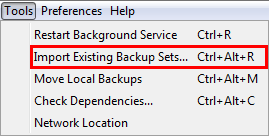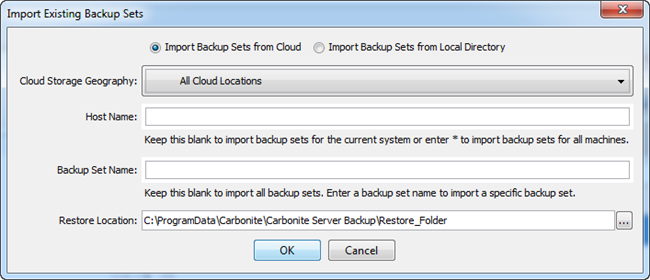Restoring a Hyper-V
- This article is for Windows only
Summary:
Carbonite Safe Server Backup (CSSB) supports the following types of restores:
Hyper-V hosts and hosted virtual machines can be restored to the original location or to an alternate location.
- All virtual machines may be restored using Restore All.
- Individual virtual machines may be restored using Restore Select.
- The Initial Store may be restored using Restore Select on Windows Server 2008 R2 and Windows Server 2012 R2.
- The Initial Store cannot be restored in Windows Server 2012.
- Files and folders within the backed up virtual machines can be restored.
- Use the Files/Folders restore option to restore the virtual hard disks. These can be mounted to the file system and browsed for individual files and folders.
- CSSB will offer to mount the drives automatically.
- For more information about restoring individual files and folders within a virtual machine, click here.
Restored virtual machines will be automatically imported into Hyper-V in most configurations. When restoring one or more virtual machines, all associated virtual hard disks will be restored.
Note: Ensure that the Restore Requirements are met before starting the restore. Additional requirements must be met for restoring files and folders.
Solution:
Restore Requirements
The following requirements must be met, whether restoring to the original computer or to an alternate computer:
- The amandabackup / CarboniteUser user must have full access to the folder where the backups are stored.
- For cloud backups, this is the chosen Download Folder.
- For local backups, this is the folder where the backups are stored on the local disk.
- If the backups are stored in a network location, amandabackup / CarboniteUser must have access to the network folder. Please refer to How to Use External or Mapped Network Drives with CSSB.
- Likewise, the amandabackup / CarboniteUser user must have full access to the folder(s) to which the backups are being restored.
- Restoring Autorecovery (.AVHDX) files to an alternate location is not supported.
Additional Requirements for Restoring Files and Folders
CSSB will offer to automatically mount a restored virtual hard disk file once the restore is complete. It will also ask if you want the mounted VHD to be displayed in Windows Explorer after the restore.
- The operating system of the restore machine must be equal to or higher than the operating system of the machine where the backup was taken.
- For example, a virtual hard disk that originated on a Windows Server 2012 system cannot be mounted to a Windows Server 2008 R2 system.
- If every possible drive letter is already in use, the VHD cannot be automatically mounted. There must be free, non-reserved drive letters available.
- The virtual hard disk must be using one of the following file systems to be automatically mounted.
- FAT
- FAT32
- NTFS
- ReFS, with some restrictions
- ReFS disks can only be mounted on Windows Server 2012 and higher with the ReFS role enabled.
- Additionally, the operating system version must match between the original system and the system performing the restore.
- Dynamic disks cannot be mounted.
Managing VHD Files After the Restore
You can manage your VHD files from within CSSB after the restore is complete. Simply right-click the Restore operation in the Report page. You will be presented with three options:
- Mount VHD: Select this option to mount a VHD file. It is subject to the same requirements shown above.
- Dismount VHD: Select this option to dismount a VHD file that is currently mounted.
- Delete VHD: Select this option to delete the VHD file from disk.
CSSB will not dismount the vhd files. You must dismount via the Report page, or do so manually using Disk Management or Powershell.
Further information about mounting and dismounting VHD files can be found in this Knowledge Base article.
Restoring to Original Location
CSSB cannot overwrite an active, running virtual machine when restoring to the Original Location. If you attempt to do so, the restore will be interrupted with the following message:
The guest VM that you are trying to restore to appears to be in running state. It will be turned off during the restore.
Are you sure you want to continue?
Select OK to turn off the running VM and continue the restore. Select Cancel to abort the restore process.
Restoring to a Different Computer
You can restore your backed up data originating from one virtual machine to a different virtual machine. This method is mostly used to create a clone of the original system. It is recommended that you install the same Windows Operating System (with the same service packs) on the target virtual machine as was installed on the original virtual machine. This procedure requires additional steps that must be performed ahead of time. The steps are as follows:
The sections below are collapsed. Please click the section title to open / close a particular section.
For complete instructions on Installing Carbonite Safe Server Backup and Importing the Cloud Certificate, please refer to the knowledge base articles linked below:
Importing Existing Backup Sets
To import existing backup sets, select Tools from the menu option and click Import Existing Backup Sets.
A Import Existing Backup Sets window will appear. You will have the option to select Import Backup Sets from Cloud or Import Backup Sets from Local Directory.
Within this screen, specify information for the following fields:
- Cloud Location - This field will only be visible when the radio button for Import Backup Sets from Cloud is selected. CSSB can back up your data to data centers across the globe. The default selection is All Cloud Locations.
- Host Name - This refers to the host name of the original computer, without the domain name.
- Enter a valid hostname to import backup sets only for the host provided.
- Enter an * (asterisk) to import backup sets for all of the computers which were backed up using CSSB.
- Leave this field blank to use the hostname of the computer on which CSSB is installed.
- Backup Set Name - This refers to the name of the backup set on the original computer when the backup was performed.
- Leave this field blank to import all backup sets.
- Use an * (asterisk) as a wildcard.
- Enter just an * to import all backup sets.
- Enter exchange* to import all backup set names that begin with exchange, such as exchangebackup, exchangeone, etc.
- The field for backup set name is case sensitive.
- Restore Location - Information about the backup sets must be downloaded to the local computer temporarily as part of the Import Existing Backup Sets process. This field allows you to specify which location on the local computer to keep this information temporarily.
- Backup Data Location - This field will only be visible when the radio button for Import Backup Sets from Local Directory is selected. It refers to the directory in which the local backups are stored.
- You must specify the exact folder in which the local backups are stored. Sub-folders will not be scanned for backups.
Restoring the Backup Data
Once the backup sets have been successfully imported by CSSB, you can follow the normal restoration steps to restore a Hyper-V.






 Feedback
Feedback